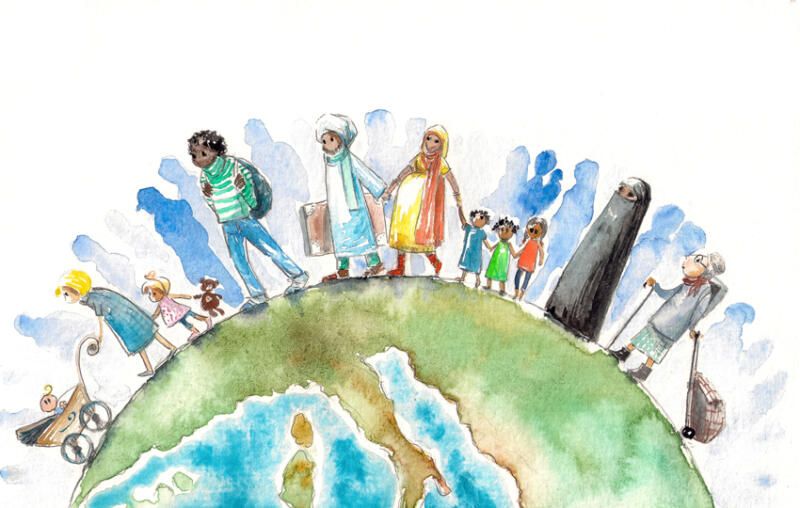As Crises Mount, Global Migrants Pay the Price
The increase in migrants fleeing rising sea levels and extreme weather, grinding poverty and growing authoritarianism is a worldwide phenomenon, not a crisis that can be reduced to the United States’ southern border.
It has increasingly been met by scapegoating of those attempting to find safety and survival amid rising populist and nativist movements in countries across Europe and much of the West.
Borders are being tightened, compounding the already dire humanitarian and political dimensions of this crisis.

To understand why there is a migration crisis and what could and should be done about it, Ethnic Media Service held a briefing, May 19, and invited several experts – Susan Fratzke, Senior Policy Analyst with Migration Policy Institute’s International Program; Andrew Rosenberg, Assistant Professor of Political Science at the University of Florida and author of “Undesirable Immigrants: Why Racism Persists in International Migration”; Amali Tower, Founder & Executive Director, Climate Refugees; and Hossein Ayazi, Policy Analyst with the Global Justice program at the Othering & Belonging Institute at the University of California, Berkeley – to offer their insights and expertise on what is among the central issues of our time.
“Within the last hundred years, what we’re seeing in terms of the numbers of people on the move and the numbers of people who are moving in ways that are very unpredictable, being forced to move in ways that are outside of normal legal migration pathways,” said Susan Fratzke, Senior Policy Analyst with Migration Policy Institute’s International Program.
“Europe alone received nearly 1 million asylum applications last year, in 2022, mostly from individuals from Syria, Afghanistan, Turkey, Venezuela, Colombia, and that’s on top of having received more than 4 million Ukrainians, who had been displaced into Europe in 2022 alone, as well as migrants and refugees who’ve come in previous years to Europe,” said Fratzke.
“In the Syrian conflict that that broke out in mid-April, more than 200,000 people have been displaced outside of Sudan by fighting just in in the last month alone, on top of 800,000 people who had already been misplaced from Sudan by fighting in the last decade, and that comes on top of refugee situations in Ethiopia, Democratic Republic of the Congo, and elsewhere in the continent,” said Fratzke.
“In Venezuela, more than 7 million Venezuelans have had to leave their home country in the last decade. Most of them have traveled to Colombia, or Peru, but also onward to the U.S., Ecuador, Chile, Spain, and Brazil,” said Fratzke.
“The displacement that we’re seeing is not just happening globally, and isn’t just the result of conflicts, displacement situations spread across the world, but also the movements are increasingly global. People are seeking refuge across the world,” said Fratzke.
“In the U.S and Mexico, people are moving across the region to look for safety. As of this winter, nearly two-thirds of the individuals who were apprehended crossing the U.S.-Mexico border were from countries other than Mexico and Central America. Many of these are South American countries – Colombia, Venezuela, or in the Caribbean, Haiti. There are also a lot of people traveling through Mexico to the U.S. Southern border from China, India, Russia, and Afghanistan,” said Fratzke.
“Every country in the world is being affected by climate change. Refugees often are living in or hosted in some of the most precarious places within a country. A good example is the Rohingya in Bangladesh, who live in a coastal area that’s very vulnerable to flooding during monsoons and heavy rains and are then experiencing the effects of sea level rise, unstable weather patterns in a way that while it affects other populations in the area, it is particularly affecting them because of where they live,” said Fratzke.
“There’s a lack of legal pathways for people to move globally. There are very few opportunities for people to move for work unless they’re at a very high skill level. Opportunities to move for family reunification, to reunify with your family elsewhere are also very limited, very restricted to traditional nuclear family definitions, and have very long wait times. The point that has been most important for my work and the issues that I’m studying is the fact that there are very few opportunities to travel legally to seek asylum if someone is at risk in their home country,” said Fratzke.
“Often, the only way to seek protection is to leave using a smuggler, using forged travel documents. That’s very unsafe. It’s very difficult to get a legal visa or some other way to move and this creates other challenges because states have been and governments have been very bad at dealing with humanitarian crises at their borders.
Andrew Rosenberg, Assistant Professor of Political Science at the University of Florida spoke on global migration, global migration crisis, and climate crisis.
“We need to think historically about where that crisis comes from. Since the 2008 global financial crisis, we’ve seen inequality and precarity increase tremendously within both the global North and the global South. Within the global North, this rising inequality and precarity is one stated cause of the rise of right-wing populism and the scapegoating of migrants from throughout the world,” said Rosenberg.
“There is absolutely no doubt that climate change is driving global displacement. Today, over 100 million people are displaced across borders across the world, due to conflict, crises, increasingly climate change, as well about 86 percent of refugees today are hosted in the global cell. Ukraine is a major game changer,” said Amali Tower, Founder & Executive Director, Climate Refugees.
“On average, about 23 million people are displaced each year by climate change and weather-related events. That happens mostly internally, within people’s own countries,” said Tower.
“I have met people who were forced to leave purely because of climate change related events and the risks they faced could have found legal protection under the Refugee Convention however, Title 42, instituted by the U.S. government since Trump era barred them from even entering the country, let alone seeking asylum. Now the countries that are historically the most vulnerable for the climate crisis are Global North countries, but they spend more money securing their borders to keep migrants out than they do on tackling the crisis that forces people from their homes in the first place,” said Tower.
“Across International Humanitarian law, Human Rights law, Refugee law, and other bodies of law, protections for climate-induced displaced persons, forced across international borders are limited, piecemeal, and not legally binding. Climate Refugee is not a legally protected category, as it should be,” Hossein Ayazi, Policy Analyst with the Global Justice program at the Othering & Belonging Institute at the University of California, Berkeley.
“There would be benefits in it becoming so. Also, far less attention has been paid to the structural causes of such displacement and the uneven experience of precarity to the Climate Crisis itself,” said Ayazi.
“The global North, through centuries of colonialism and enslavement, and wealth and natural resource extraction, has severely impoverished the global South. The vast wealth resource and infrastructure inequality between the global South and global North has hindered social, political, economic, and environmental resilience in the global South in a host of ways. This is resilience to economic shocks, to environmental degradation, to political conflict, to social conflict,” said Ayazi.
Focusing on the past 50 years, Ayazi pointed that, “even after the formal end of colonialism, the global North has maintained this inequality through things like the predatory lending to global South nations, to supposedly help them develop, while imposing harsh debt repayment priorities, and forcefully opening global South markets to powerful global North firms.
“Predatory lending has happened internationally with the help of dominant international financial institutions like the International Monetary Fund, and the World Bank, the World Trade Organization. These International financial institutions have collectively forced countries across Africa, Asia, South and Central America, to stick to things like agricultural production to the continued benefit of the global North,” said Ayazi.
“These policies and practices led to sharp shrinkage in government funds for education, health, and infrastructure, undermined the development of adequate infrastructure that might help communities cope with climate impacts, that might actually preclude people’s need to move internally and across borders,” said Ayazi.
“These types of predatory policies and practices have entrenched global North-South relations of dependency, that have forced many global South countries into deriving a relatively large percentage of their GDP, upwards of 60% in some countries, from things like agriculture, forestry, and fishing. These are industries. 60% of a country’s GDP required is dependent upon these industries and these are industries, that are by nature, more vulnerable to a change in climate and intense weather. This is like the legacy of hundreds of years of the underdevelopment of the global South. As such a large majority of the world’s board depends upon moderate weather patterns and seasonal changes for their livelihoods, what will certainly be compromised further as the climate crisis worsens, and thus forcing many people to relocate when staying in place becomes untenable,” said Ayazi.
Ayazi shared the findings of a recent survey by Othering & Belonging Institute, “We surveyed several dozen African climate, agri-food, and environmental organizations, working across the five regions on the African continent. We wanted to see essentially how they’re building climate resilience; what terms they’re using themselves; what demands they’re making; ways that we based at UC Berkeley and other global North institutions can support such work without kind of imposing top-down ideas.
“Respondents shared that their work is focused on, above all, creating local and regional economies and local development trajectories that are sustainable and just that aren’t extractive and that don’t require fossil fuels,” Ayazi.
“Most respondents shared that their long-term strategy for building local and sustainable economies that kind of build climate resilience is by scaling up sustainable agriculture such as agroecological methods and reduced petrochemical use.
“Research has shown time and time again that agroecological food systems, that sustainable food systems, are far more resilient to climate impacts, while supporting communities themselves socially, politically, economically, and so on,” said Ayazi.
“Food systems are a way to build climate resilience. There’s not something inherently dispossessive or exploitative about them but rather an opportunity.
“The global North and global North organizations and Civil Society must reduce the global North’s exploitation of land resources and labor from the global South,” said Ayazi.


